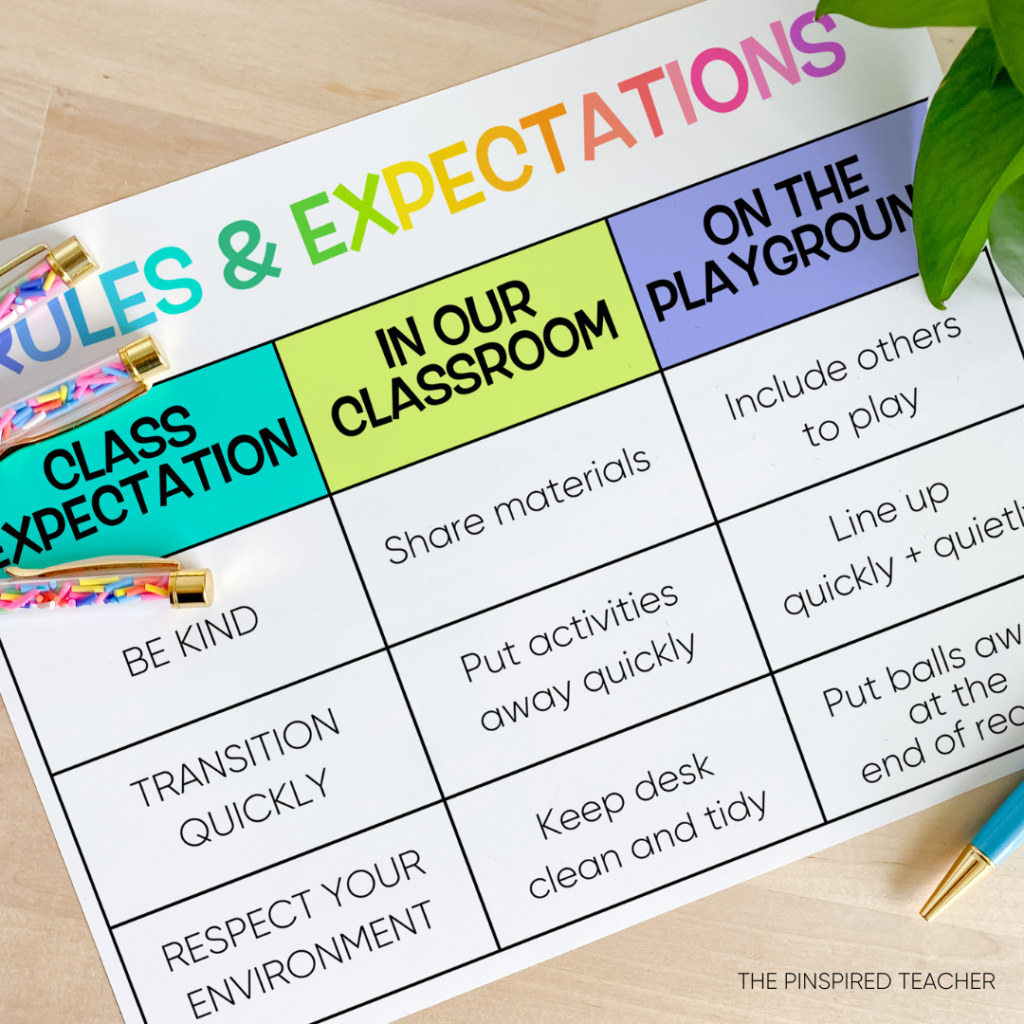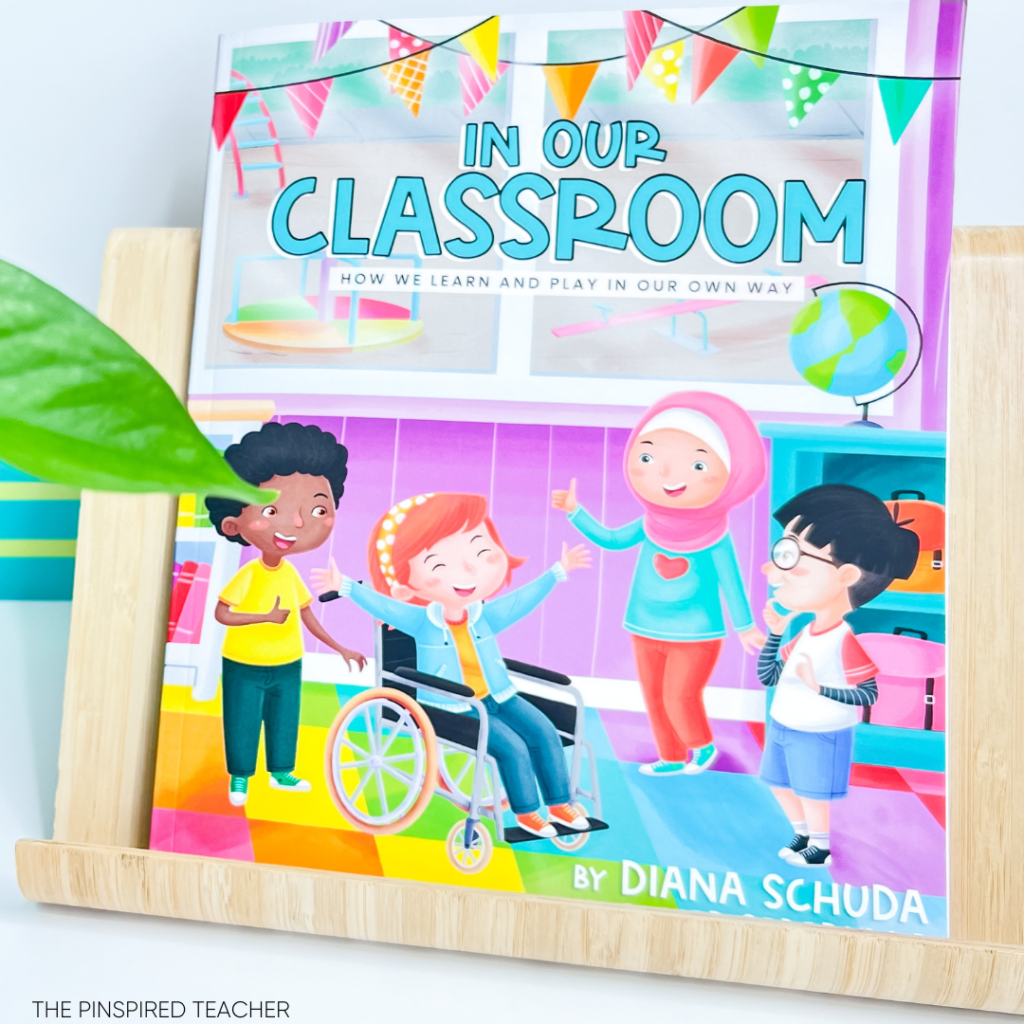As the school year begins, you may be wondering what rules and expectations you should set for your kindergarten students in order to encourage good behavior. With young children, it is important to keep things simple. A few well-chosen rules and expectations can go a long way toward promoting positive behavior in your classroom. Whether you’re a brand new kindergarten teacher or you’ve been teaching for a while and want to refresh your class rules, you’re in the right place. This post will cover a few suggestions for kindergarten classroom rules and expectations that will help create a happy and productive learning environment.
Kindergarten Classroom Rules and Expectations
What is the difference between classroom rules and expectations?
Classroom rules are specific behaviors that you expect your students to adhere to while classroom expectations are the overall attitude and atmosphere you create in your classroom.
Keep in mind, that classroom rules and classroom expectations are not interchangeable terms. A trick to remembering it is using alphabetical order, “e” comes before “r” and the same goes when it comes to expectations and rules. Your expectations are set first and they then dictate what your class rules are.
Another way to remember the difference between rules vs expectations is the expectation is the vibe of your classroom- it’s very broad, while rules, on the other hand, specifically define the vibe.
Your class rules paint a specific picture of your expectations in your students’ minds. You can’t picture being responsible, but you can picture bringing your homework.
See the difference?
Here’s another example:
If you want to say that your classroom expectation is being respectful, your classroom rules translate that to specific scenarios such as: raising your hand, keeping your hands to yourself, not interrupting, etc.
A great anchor chart to make is a matrix that shows the expectations and then you and your class come up with the rules for different settings:

Why are class expectations more important than rules?
While rules are important, it is also essential to nurture a positive classroom community where students feel safe, respected, and valued. By setting clear expectations for behavior, you can help create a classroom environment that is conducive to learning.
In our Classroom by Diana Schuda is the PERFECT book for helping set expectations during the first week of school:

Here are a few examples of kindergarten classroom expectations:
- We are a community.
- We are kind and caring to each other.
- We listen to each other.
- We help each other.
- We follow directions.
- We play safely.
- Our school is a safe place for everyone.
That’s different from rules like these:
- Keep your hands and feet to yourself.
- Raise your hand to speak.
- Use inside voices.
- Listen when others are speaking.
20 Classroom Rules Examples:
Now that you know why classroom rules and expectations are important as well as the difference between them, it’s time to start thinking about what your kindergarten classroom rules will be this year. Whether you pick your kindergarten classroom rules before you meet your class or you brainstorm ones together, it’s always good to have an idea of options! So, what are some examples of simple kindergarten classroom rules? Let’s take a look!
- Listen when others are speaking.
- Keep your hands and feet to yourself.
- Use quiet voices.
- Help keep our classroom clean
- Follow directions the first time they are given.
- Follow directions quickly.
- Put materials back after using them.
- Only one person speaks at a time.
- Help each other out.
- Raise your hand to speak.
- Use school supplies safely.
- Use manners and kind words like “please” and “thank you.”
- Listen to the person speaking.
- Keep your table or desk tidy.
- Use walking feet in the hallway.
- Be on time.
- Use inside voices.
- Ask for permission to leave the classroom.
- Share materials with others.
- Do not tease.
Choose 3-5 Simple Rules for the First Day
While I just listed over 20 examples of general rules, you’ll want to narrow it down to the ones you think align with your overall goals and expectations for your classroom. A great place to begin is to look at your school rules and expectations. What are the most important things that you want to carry into your classroom? Some kindergarten teachers I know simply use their school rules as their class rules. My favorite is to share the school expectations on the first day of school and use them to springboard into a conversation about what the school expectations would look like in the classroom. For example, if the school rule is to be respectful, you can make an anchor chart for that rule and brainstorm together what “being respectful” looks like and sounds like in class.
From there, you can generate a list of 3-5 simple classroom rules that will guide your students throughout the year.
Use Anchor Charts for Kindergarten Classroom Rules
You can make a class rules bulletin board that has anchor charts that display your kindergarten classroom rules. This class rules and expectations bulletin board can be a great visual reminder for your students of what the expectations are in class. You can also add to it or change it as needed throughout the year.
Anchor charts are also a great way to introduce the concept of rules to younger students. They provide a concrete way for students to see and understand what is expected of them. For example, you can draw a picture of what “walking feet” or “whole body listening” looks like on an anchor chart. In addition, anchor charts can be a helpful tool for teachers to refer back to when reminding students of the rules.
Tip: Display the rules poster or anchor chart at the children’s eye level.
You Might Like My Book: Anchor Charts for 1st to 5th grade Teachers
Set Clear Expectations for the Different Rules You Establish
You want your entire class to follow the basic rules of your kindergarten classroom. The best thing is a whole class “buy-in” of the commitment to making good choices and following expectations by the end of first week of school. Your students need to understand why it’s important. Don’t wait. The sooner you set clear expectations, the smoother your year will go.
Ok, now that we’ve gone over some examples of simple kindergarten classroom rules, let’s take a look at a few expectations you can set for your students. These class expectations will help promote positive behavior for all of your new kindergartners.
Be on time and ready to learn
This expectation goes hand-in-hand with the rule about following directions quickly. When students are on time and ready to learn, it helps the day run smoothly and keeps everyone on track.
In order to help your students be on time and ready to learn, you can:
-Set a daily routine and schedule that your class becomes familiar with.
-Have a designated place for students to put their things (e.g., hooks for backpacks, cubbies for jackets and lunchboxes).
-Kindergartners aren’t in control of when they arrive, but you can talk about things that will help them be on time such as not lingering in the hallway talking to other students from other classes.
Transition quickly between activities.
This expectation also goes well with the rule of following directions quickly because students need to be able to transition quickly in order to maximize instructional time.
In order to help your students transition quickly, you can:
- Use visual cues (e.g., a timer, a specific number of claps, or a certain song) to signal when it’s time to move on.
- Model and practice how to transition quickly and efficiently between activities.
- Give your students a specific task to do during each transition (e.g., “Get your supplies ready for the next activity”) and time it.
Stay in your own space.
This expectation is important for maintaining order and preventing chaos in the classroom. When students stay in their own space, it helps everyone to stay focused and on task.
In order to help your students stay in their own space, you can:
- Use furniture arrangements to create defined spaces for each student (e.g., desks in rows or groups, carpet squares).
- Use physical cues (e.g., velcro spots or tape on the floor) to show students where their space is (for the carpet, lining up, etc.).
- Model for your students how to stay in their own space.
Be a good listener.
This expectation is important for ensuring that all students are engaged and participating in class. Explain to your students that when they are listening, they are able to learn and remember information better.
In order to help your students be good listeners, you can:
- Model for your students how to be a good listener (e.g., make eye contact, sit quietly, raise their hand to speak-keep in mind the different cultures of your students and how that might impact your expectations).
- Give your students specific listening tasks to do during each lesson (e.g., “Listen for three things that the character says”).
Be kind and help others
One of the most important things you can teach your students is to be kind and helpful to others. Not only does this create a more positive classroom environment, but it also helps instill values of empathy, compassion, and respect.
There are many ways you can encourage students to be kind and helpful to others, such as:
- Encouraging students to use kind words and phrases with one another.
- Teaching students how to resolve conflicts peacefully.
- Model for your students how to be a good friend.
- Encouraging students to help clean up or put away materials.
- Helping students understand and celebrate differences.
- Providing opportunities for students to work cooperatively in small groups.
That’s why In our Classroom makes the perfect book – because it covers everything I just mentioned. (Can you tell I’m a big fan? lol)
How to Introduce Classroom Rules to Kindergarteners on the First Day of School
For many young students, kindergarten is the first year of school, no naps or half days. One of the best ways to introduce your kindergarten classroom rules, is with picture books!
Class Rules Books
(Stay tuned, I will be making a long list of great books that help introduce class rules, procedures, and expectations!)
Once you’ve done class read aloud, brainstormed or introduce the rules, assign hand motions to your rules to make learning them fun and memorable. For example, for the rule ‘keep your hands to yourself’, a hand motion can be the students placing their hands on their sides or hugging themselves.
What about new students who join later in the school year?
Your new students need to know the appropriate rules that you and your class established at the beginning of the year. I recommend re-reading a book you read at the beginning of the year that introduced your expectations and rules, such as In our Classroom, any time a new student joins your classroom community. Then refer back to the anchor charts that display your rules and expectations and have a class meeting about what it’s like to be a member of the class.
Keep Up with Your Classroom RULES ALL YEAR LONG
Kindergarten is an important year for setting the foundation of positive behavior and academic success. By having clear and simple rules, you can create a happy and productive learning environment for all and prevent unwanted behaviors from popping up. Good luck to the start of your new school year!
[…] SETTING SIMPLE CLASSROOM RULES AND EXPECTATIONS […]